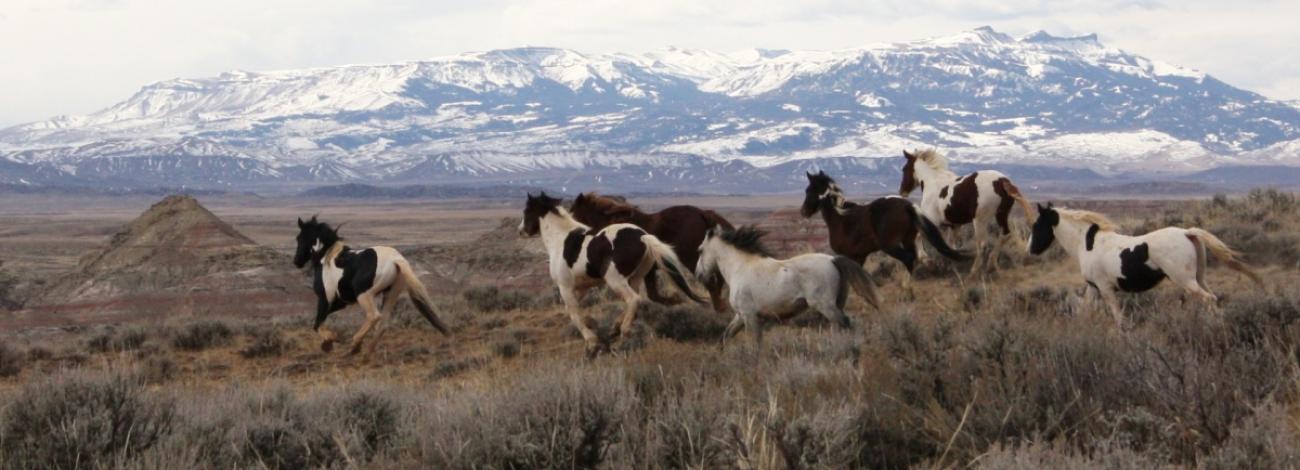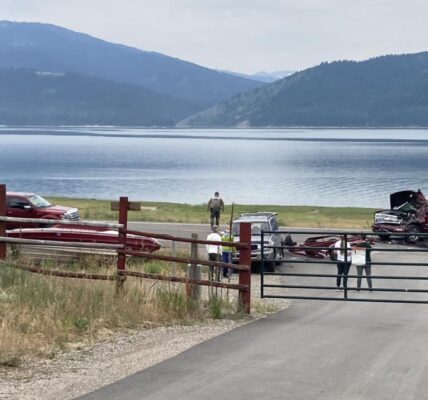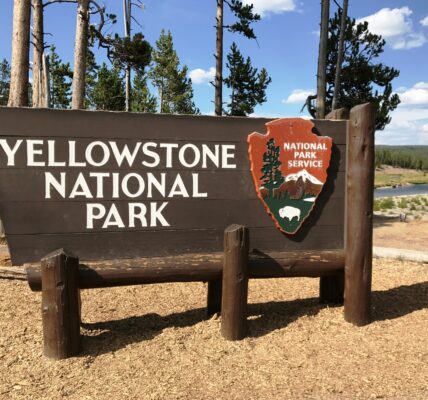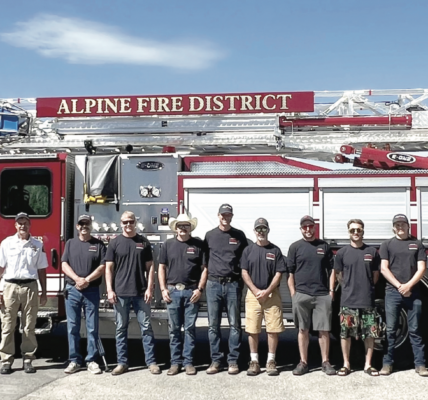
By Zak Sonntag
Casper Star-Tribune
Via- Wyoming News Exchange
CASPER — The McCullough Peaks wild horse herd is famously photogenic. It’s known for robust mares and stallions with a rich diversity of coat colorings, from pinto and palomino to blue and strawberry roan.
The terrain they inhabit is equally diverse, and stocked with wild beauty. Throughout the 113,938 acres of McCullough Peaks Wilderness Area, the herd is found roaming amidst the desert mountain foothills, rolling sage prairie, and into loamy badlands beyond. The herd has a presence in the area dating back centuries, and its reputation has spawned a small cottage industry of wild horse tourism in the nearby city of Cody.
But its historic range over the decades has shrunk, and soon the herd will too.
The BLM Cody Field Office is moving forward with a controversial bait trap gather that aims to remove around 40 mustangs and reduce the herd total to 140, considered within the Appropriate Management Level (AML) established by a 2015 Cody Resource Management Plan.
BLM officials say the removal is needed to promote healthy rangeland and multiple use objectives for a “thriving ecological natural balance” required by the Wild Horse and Burro Act of 1977.
The herd’s growing fan base, however, have come out strongly against the removal plan.
Its members say the management area can support the herd’s existing numbers and more without compromising multiple-use objectives, and they believe that the BLM’s assessment is tilted in favor of other uses, like livestock.
“Public lands are supposed to be multiple use, but the ranchers who have the permits don’t want to share. I’m not anti rancher, but I think that the horses need to be able to live where they’re where they’re supposed to live,” said Carol Walker, a wild horse photographer who’s studied the McCullough Peaks herd for two decades. “You’re talking about 175 adult horses on 110,000 acres. That’s not a huge impact. But when you talk about hundreds and hundreds of cattle out there, virtually your round, they’re the ones that make a big impact on the range.”
The McCullough Peaks Herd Managed Area (HMA) encompasses six grazing allotments, and under the Cody RMP has 6,179 animal unit months (the amount of forage to sustain one cow for a month). There are currently three livestock permittees operating within the HMA. (Permittees could not be reached for comment.)
The BLM assessment does not include a complete rangeland analysis for the entire HMA. Nonetheless, ecological site inventory studies show that mustangs are significantly more erosive than livestock per capita, and that allowing the herd to stay above the AML would result in “severe range degradation,” according to BLM-Wyoming officials.
One of the reasons is that livestock are rotated and confined to specific pastures for specific periods, allowing land managers to limit vegetation impacts during critical growing periods. Mustangs, on the other hand, are present across the entire range and impact a variety of its micro-habitats year-round, including riparian areas and priority sage-grouse habitat.
“You could have several hundred horses out there, sure. But you’re going to see a detriment to other organisms and wildlife,” said Micky Fisher, Public Affairs representative for BLM-Wyoming.
Even still, wild horse advocates argue the gathering is unnecessary because the herd is already on the verge of losing numbers by natural causes.
The American Wild Horse Campaign explained in a petition letter that 36% of the herd’s mares are over the age of 15, and 23 mares are over the age of 20. This makes it a disproportionately elderly group liable to lose as many as 20 mustangs in the coming winter, the letter states.
In some ways the herd’s elderliness is the effect of another population control tactic: immunocontraception.
The BLM in 2011 began systematically treating McCullough Peaks’ mares with a drug called Porcine Zona Pellucida vaccine (PZP), applied in the field via cartridge-fired dart rifle. It’s a method supported by wild horse advocates and has kept the herd’s growth around 2% a year. (Officials say the herd would grow 20% annually if left unmanaged.)
Contraceptive measures have actually increased the herd’s life expectancy because they reduce the stress and physical toll of foaling.
However, in addition to PZP, the impending gather comes at a time when the BLM has begun implementation of a new fertility control drug, which some worry could have unknown repercussions on the herd’s genetic viability.
For the first time on the McCullough Peaks herd, the BLM will begin the application of a drug known as GonaCon-Equine vaccine, a longer lasting contraceptive that increases the likelihood of permanent sterility. The drug is gaining favor in the world of wild horse management because of its longer lasting effects; whereas PZP must be applied annually, GonaCon can last up to four years. Managers say it’s also needed to curtail the reproductivity of “non-responding mares” on which PZP has proven ineffective.
The decision troubles some horse advocates, who say not enough is known about the interaction between these separate fertility drugs and its use could have long term implications on herd diversity.
Sandy Sisti is pharmaceutical expert and volunteer darter with the Cody BLM, but after more than a decade of working with McCullough Peaks herd, Sisti says she cannot in good conscience dart with GonaCon.
“I can’t find any data that shows that using GonaCon on top of PZP would not have any negative impacts. Not knowing if there will be adverse drug interactions, to me that’s not acceptable, especially since we don’t have that many breeding age mares in the population,” Sisti said. “Now that they’re going to start using GonaCon, I don’t want to be involved in darting the horses. It’s concerning.”
The drug, nonetheless, has been approved for use, and the BLM assessment cites myriad studies indicating its safety, including a study showing that horses treated with GonaCon return to full fertility in under four years. The proposal stipulates that GonaCon will only be used on mares over the age of 13 who’ve already contributed offspring to the gene pool, although the systematic application of fertility control raises additional concerns, particularly for the herd’s genetic viability.
On the one hand, non-responding mares are diminishing the herd’s genetic diversity by stacking the gene pool with their DNA, which could be problematic in that their resistance to PZP may indicate an immune deficiency. In this way, the application of GonaCon could help managers control for a more diversified gene pool.
On the other hand, the herd’s current population is already below the threshold of a “genetically viable“ population, according to leading equine geneticist, Dr. Gus Cothran, Director of the Equine Blood Typing Research Laboratory at the University of Kentucky.
In peer-reviewed reports, Cothran says a herd needs a minimum of 150-200 animals with at least 100 breeding age animals in order to maintain the genetic viability required for species resilience. The AML established for the McCullough peaks herd is 70 -140.
“That AML is an arbitrary number. And this is a historic herd that has been there for a very long time,” said Walker. “So they really are a cultural and historic resource, as well.”
The BLM counters that its decisions are informed by both voluminous scientific study as well as public input, and representatives say they’ve worked with activists to implement humane practices, including limiting more controversial gathering techniques like helicopter roundups.
“We are not as much a part of the discussion, per se. It isn’t us picking a side. We’re just moving forward with what the law that the American people through Congress has already established for us to do,” said Fisher, referring to the Wild Horse and Burro Act of 1977.





